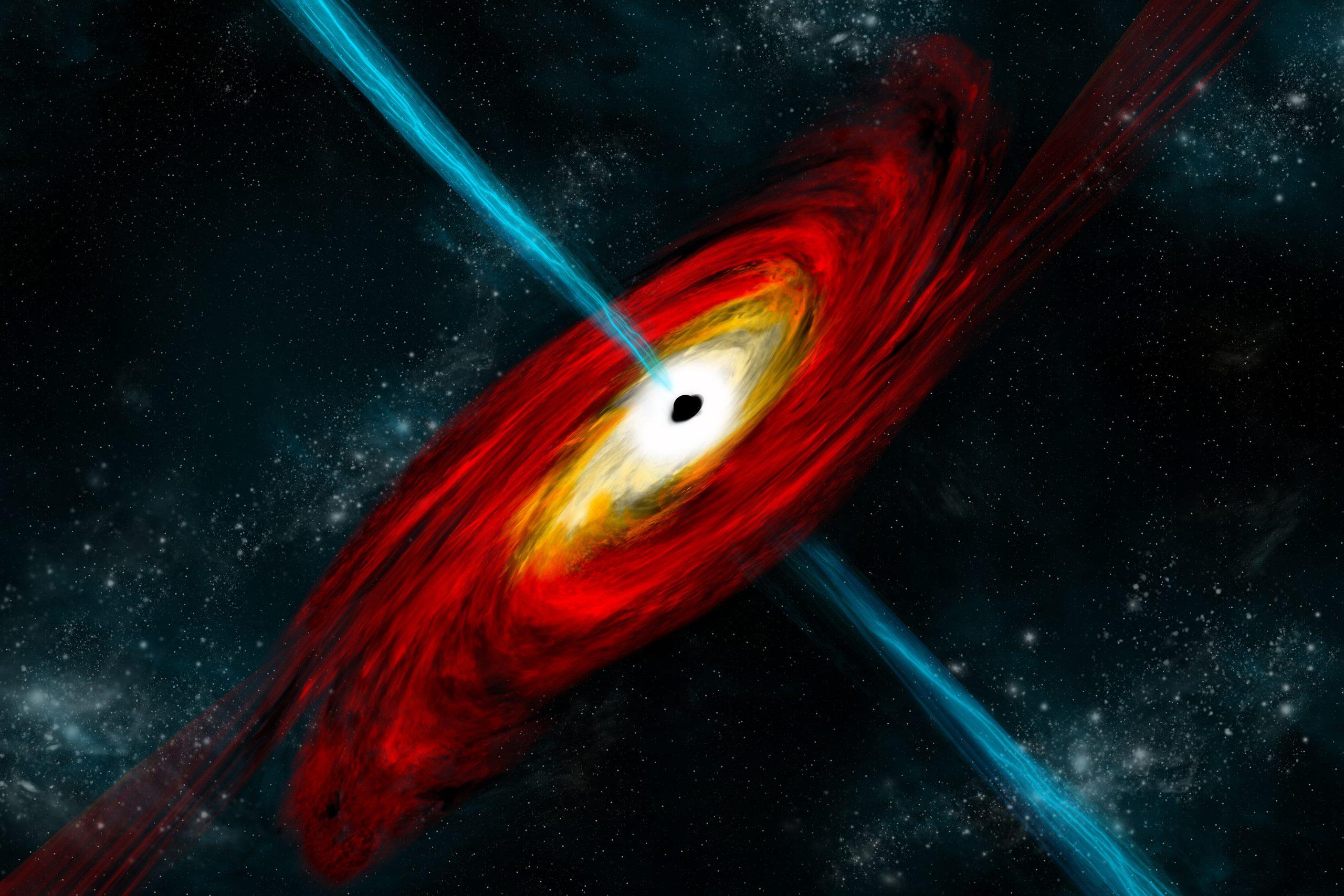
Adobe Stock https://www.psc.edu/wp-content/uploads/2024/05/AdobeStock_94796347.jpeg
Sims Will Allow Future Telescopes to Identify What Kinds of Jets Emerge as Super Massive Black Holes Eat Matter from Their Surrounding Galaxies
Active galactic nuclei (AGNs) are massive black holes that spit out enormous jets as they devour matter from the galaxies that surround them. A multi-institutional effort led by computational work at Harvard University used PSC’s Bridges-2 to simulate these monsters, showing how different types of jets will produce different effects on their host galaxies. The work gives astronomers different signatures they should look for using future telescopes, enabling them to identify which types of jets are actually present.
WHY IT’S IMPORTANT
The Universe can be a scary place. You may have heard of Sagittarius A*, the mammoth black hole that sits at the center of our Milky Way galaxy. We’re safe from being eaten by it, though. Like virtually all of the Milky Way’s stars, our Sun orbits it at a safe distance.
Not so much the AGNs sitting in other, massive galaxies. These monster black holes aren’t so well behaved. They actively consume gas and stars, belching out vast, energetic jets as they do.
And that leads to a question. The gas and stars in the halos of these galaxies — more distant stars and gas orbiting the galaxy in erratic orbits, as opposed to the ones revolving in the orderly galactic disk — are hotter than they’d be if their black holes were inactive, like the Milky Way’s.
Of course, we know that the AGN jets are heating up these halos. Astronomers just don’t know exactly how they’re doing it.
“Without those active galactic nuclei, the gas in the massive galactic halo would cool down and fall toward the center of the galaxy and form stars at a rate much larger than observed in massive galaxies … That’s the inconsistency, that’s why we need to put the active galactic nuclei into our simulations to reproduce the actual massive galaxies.” — Kung-Yi Su, Harvard University
Based on the team’s earlier work, AGN jets can do the job in three different ways. A precessing fast kinetic jet, like a rotating sprinkler, could stir the halo gas up. A slightly less kinetic cosmic ray-dominant jet could do the job too, as its relativistic particles, moving near the speed of light, provide energy that isn’t easily radiated away. Finally, a hot thermal jet’s relatively slow particles carry a high temperature that also could transfer to the halo.
Distinguishing between the three types of jets will require combining observations from telescopes of different wavelengths. New generations of telescopes will also help. But astronomers could tell the difference between each type of jet more easily if they had a better idea of what each would look like in the new telescopes.
A multi-institutional team including scientists at Harvard University, Columbia University, the Flatiron Institute, Caltech, and elsewhere, wanted to simulate AGN galaxies to predict the signatures of each type of jet. These simulations would require massive computational power. The team turned to PSC’s NSF-funded Bridges-2 supercomputer.
HOW PSC HELPED
To see how each type of jet would affect the properties of their halo gas, the team, led by Kung-Yi Su, a Black Hole Initiative Fellow at Harvard, would need to simulate the three different types of jets under different assumptions and conditions. Bridges-2’s regular memory nodes, with a massive 256 to 512 gigabytes of memory each, could both handle the computations and do a large number of them in parallel. The scientists gained access to Bridges-2 through an allocation from ACCESS, the NSF’s network of supercomputing centers, in which PSC is a leading member.
“I’m doing an extensive set of isolated simulations … Each of the runs roughly takes four to eight nodes. It’s not super-computationally expensive for each of the runs. But [thanks to Bridges-2] I can run many [of them] simultaneously … in the past year, I’ve done about two thirds of my computational work on Bridges-2.” — Kung-Yi Su, Harvard University
A series of three studies will help the scientists narrow down the signatures of each type of jet.
In a paper in the Monthly Notices of the Royal Astronomical Society (MNRAS) in July 2021, the team tested the three types of jets in a massive AGN galaxy roughly 100 times larger than the Milky Way — 1014, or 100 million million, times the mass of our Sun. Cosmic ray jets were the most efficient. Thermal jets, they found, would work but require 10 times more energy than cosmic ray jets. Kinetic jets were inefficient at heating the halo; they need to precess to work. The findings didn’t rule out any of these possibilities. But it helped set the parameters for the next studies.
A more ambitious study, which the team published in MNRAS in July 2024, repeated the work in a much larger range of galaxy sizes — 1012 to 1015 solar masses, from roughly the size of the Milky Way to a thousand times larger. This work confirmed the earlier paper under more conditions. Again, the simulated cosmic ray jets were the most efficient, with kinetic jets needing to precess and thermal jets requiring more energy.
In an upcoming paper, undergraduate student Nadia Qutob of Georgia Tech found that the three types of jet would push different chemical elements to different parts of a Milky Way-sized AGN galaxy. Each type of simulated AGM jet would produce a different distribution of electrically charged ions — a signal that new telescopes will be able to detect.
The scientists are continuing their simulations on Bridges-2, refining and expanding their predictions to provide astronomers with more specific targets for future inquiries. They’re also ruling out particular types and energy ranges of jets that could still produce the signals scientists already see.
